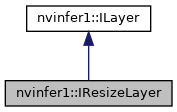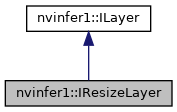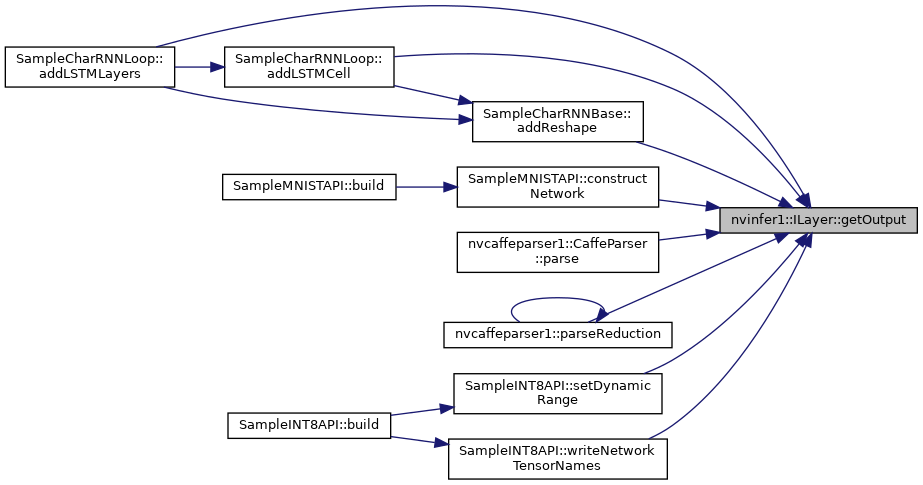A resize layer in a network definition. More...


Public Member Functions | |
| virtual void | setOutputDimensions (Dims dimensions)=0 |
| Set the output dimensions. More... | |
| virtual Dims | getOutputDimensions () const =0 |
| Get the output dimensions. More... | |
| virtual void | setScales (const float *scales, int32_t nbScales)=0 |
| Set the resize scales. More... | |
| virtual int32_t | getScales (int32_t size, float *scales) const =0 |
| Copies resize scales to scales[0, ..., nbScales-1], where nbScales is the number of scales that were set. More... | |
| virtual void | setResizeMode (ResizeMode resizeMode)=0 |
| Set resize mode for an input tensor. More... | |
| virtual ResizeMode | getResizeMode () const =0 |
| Get resize mode for an input tensor. More... | |
| virtual void | setAlignCorners (bool alignCorners)=0 |
| Set whether to align corners while resizing. More... | |
| virtual bool | getAlignCorners () const =0 |
| True if align corners has been set. More... | |
| void | setInput (int32_t index, ITensor &tensor)=0 |
| Append or replace an input of this layer with a specific tensor. More... | |
| virtual LayerType | getType () const =0 |
| Return the type of a layer. More... | |
| virtual void | setName (const char *name)=0 |
| Set the name of a layer. More... | |
| virtual const char * | getName () const =0 |
| Return the name of a layer. More... | |
| virtual int32_t | getNbInputs () const =0 |
| Get the number of inputs of a layer. More... | |
| virtual ITensor * | getInput (int32_t index) const =0 |
| Get the layer input corresponding to the given index. More... | |
| virtual int32_t | getNbOutputs () const =0 |
| Get the number of outputs of a layer. More... | |
| virtual ITensor * | getOutput (int32_t index) const =0 |
| Get the layer output corresponding to the given index. More... | |
| virtual void | setPrecision (DataType dataType)=0 |
| Set the computational precision of this layer. More... | |
| virtual DataType | getPrecision () const =0 |
| get the computational precision of this layer More... | |
| virtual bool | precisionIsSet () const =0 |
| whether the computational precision has been set for this layer More... | |
| virtual void | resetPrecision ()=0 |
| reset the computational precision for this layer More... | |
| virtual void | setOutputType (int32_t index, DataType dataType)=0 |
| Set the output type of this layer. More... | |
| virtual DataType | getOutputType (int32_t index) const =0 |
| get the output type of this layer More... | |
| virtual bool | outputTypeIsSet (int32_t index) const =0 |
| whether the output type has been set for this layer More... | |
| virtual void | resetOutputType (int32_t index)=0 |
| reset the output type for this layer More... | |
Protected Member Functions | |
| virtual | ~IResizeLayer () |
A resize layer in a network definition.
Resize layer can be used for resizing a ND tensor.
Resize layer currently supports the following configurations:
m dimensions of ND, where 0 < m <= min(8, N) and N > 0m dimensions of ND, where 0 < m <= min(3, N) and N > 0Default resize mode is ResizeMode::kNEAREST. Resize layer provides two ways to resize tensor dimensions.
|
inlineprotectedvirtual |
|
pure virtual |
Set the output dimensions.
| dimensions | The output dimensions. Number of output dimensions must be the same as the number of input dimensions. |
If there is a second input, i.e. resize layer is dynamic, calling setOutputDimensions() is an error and does not update the dimensions.
Output dimensions can be specified directly, or via scale factors relative to input dimensions. Scales for resize can be provided using setScales().
|
pure virtual |
Get the output dimensions.
|
pure virtual |
Set the resize scales.
| scales | An array of resize scales. |
| nbScales | Number of scales. Number of scales must be equal to the number of input dimensions. |
If there is a second input, i.e. resize layer is dynamic, calling setScales() is an error and does not update the scales.
Output dimensions are calculated as follows: outputDims[i] = floor(inputDims[i] * scales[i])
Output dimensions can be specified directly, or via scale factors relative to input dimensions. Output dimensions can be provided directly using setOutputDimensions().
|
pure virtual |
Copies resize scales to scales[0, ..., nbScales-1], where nbScales is the number of scales that were set.
| size | The number of scales to get. If size != nbScales, no scales will be copied. |
| scales | Pointer to where to copy the scales. Scales will be copied only if size == nbScales and scales != nullptr. |
In case the size is not known consider using size = 0 and scales = nullptr. This method will return the number of resize scales.
|
pure virtual |
Set resize mode for an input tensor.
Supported resize modes are Nearest Neighbor and Linear.
|
pure virtual |
Get resize mode for an input tensor.
|
pure virtual |
Set whether to align corners while resizing.
If true, the centers of the 4 corner pixels of both input and output tensors are aligned i.e. preserves the values of corner pixels.
Default: false.
|
pure virtual |
True if align corners has been set.
|
pure virtual |
Append or replace an input of this layer with a specific tensor.
| index | the index of the input to modify. |
| tensor | the new input tensor |
Sets the input tensor for the given index. The index must be 0 for a static resize layer. A static resize layer is converted to a dynamic resize layer by calling setInput with an index 1. A dynamic resize layer cannot be converted back to a static resize layer.
For a dynamic resize layer, the values 0 and 1 are valid. The indices in the dynamic case are as follows:
If this function is called with a value 1, then the function getNbInputs() changes from returning 1 to 2.
Implements nvinfer1::ILayer.
|
pure virtualinherited |
Return the type of a layer.
|
pure virtualinherited |
Set the name of a layer.
This method copies the name string.

|
pure virtualinherited |
|
pure virtualinherited |
Get the number of inputs of a layer.
|
pure virtualinherited |
Get the layer input corresponding to the given index.
| index | The index of the input tensor. |
|
pure virtualinherited |
Get the number of outputs of a layer.

|
pure virtualinherited |
Get the layer output corresponding to the given index.

|
pure virtualinherited |
Set the computational precision of this layer.
Setting the precision allows TensorRT to choose implementation which run at this computational precision. Layer input type would also get inferred from layer computational precision. TensorRT could still choose a non-conforming fastest implementation ignoring set layer precision. Use BuilderFlag::kSTRICT_TYPES to force choose implementations with requested precision. In case no implementation is found with requested precision, TensorRT would choose available fastest implementation. If precision is not set, TensorRT will select the layer computational precision and layer input type based on performance considerations and the flags specified to the builder.
| precision | the computational precision. |
|
pure virtualinherited |
get the computational precision of this layer
|
pure virtualinherited |
whether the computational precision has been set for this layer
|
pure virtualinherited |
reset the computational precision for this layer
|
pure virtualinherited |
Set the output type of this layer.
Setting the output type constrains TensorRT to choose implementations which generate output data with the given type. If it is not set, TensorRT will select output type based on layer computational precision. TensorRT could still choose non-conforming output type based on fastest implementation. Use BuilderFlag::kSTRICT_TYPES to force choose requested output type. In case layer precision is not specified, output type would depend on chosen implementation based on performance considerations and the flags specified to the builder.
This method cannot be used to set the data type of the second output tensor of the TopK layer. The data type of the second output tensor of the topK layer is always Int32. Also the output type of all layers that are shape operations must be DataType::kINT32, and all attempts to set the output type to some other data type will be ignored except for issuing an error message.
Note that the layer output type is generally not identical to the data type of the output tensor, as TensorRT may insert implicit reformatting operations to convert the former to the latter. Calling layer->setOutputType(i, type) has no effect on the data type of the i-th output tensor of layer, and users need to call layer->getOutput(i)->setType(type) to change the tensor data type. This is particularly relevant if the tensor is marked as a network output, since only setType() [but not setOutputType()] will affect the data representation in the corresponding output binding.
| index | the index of the output to set |
| dataType | the type of the output |
|
pure virtualinherited |
get the output type of this layer
| index | the index of the output |
|
pure virtualinherited |
whether the output type has been set for this layer
| index | the index of the output |
|
pure virtualinherited |
reset the output type for this layer
| index | the index of the output |